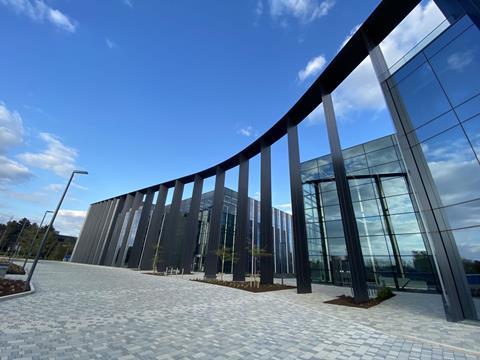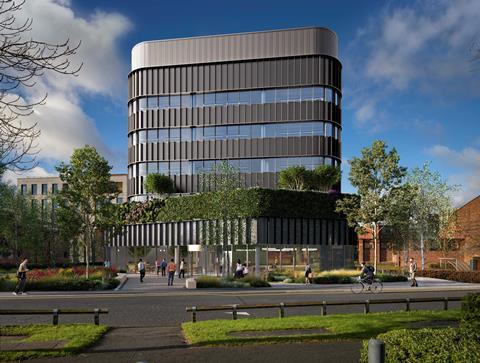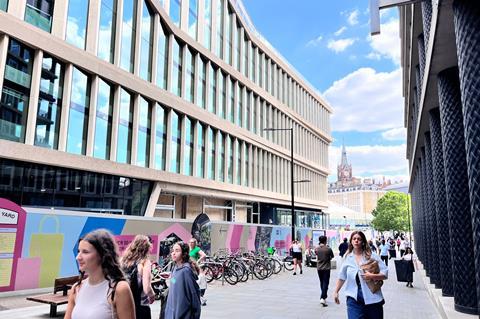Our quick guide to some of construction’s major clients across different sectors covers pipelines, priorities and procurement routes

Despite the optimistic tone set by the arrival of a new Labour government, construction output is still shaky. While the month of May saw an uptick of 1.9%, the three previous months’ output fell 0.7%, with many construction firms still experiencing challenging market conditions.
There are clients with solid pipelines across the various sectors who look set to weather economic fluctuations. So, who are they and what do they want?
Commercial/offices
Great Portland Estates

What do we know about the senior management team?
Chief executive Toby Courtauld has led the listed firm for more than 22 years. Director of digital and technology is Jordan Mclean (a veteran of Asda and Morrisons) who recently announced he has “reshaped” his team with new hire Margherita Ceraolo (formerly of YOOX Net-A-Porter and Autotrader) joining as head of digital and technology delivery.
What’s the company’s pipeline of construction work looking like?
The firm says it has a £1.4bn pipeline of acquisitions and “exciting plans” for new openings in 2024 having raised £350m via a rights issue in June to invest in London’s “attractive” commercial property market. It says void rates remained at a “near record low” of 1.2% at 31 May 2024.
Earlier this year it let 5,000sq ft of retail space at 141 Wardour Street to Represent. It says it has a further £1.5bn of opportunities on its watchlist.
Great Portland Estates has also said it has not given up on its New City Court scheme near London Bridge after its proposals to build towers of alternative heights were turned down last year. Then communities secretary Michael Gove kicked its plans into touch last September with GPE at the time saying it was working out what to do next – which now includes looking at extending and reusing the building.
How does it procure construction work?
The listed 65-year-old London-focused firm owns and manages 30 office buildings in London’s West End, Soho, Fitzrovia, Marylebone, St James’s, London Bridge, Whitechapel, Clerkenwell and the City. It says it engages partners who understand its “one team” collaborative ethos and are considered market leaders.
Last month it completed a “property swap” with the City of London Corporation to acquire a long leasehold interest in The Courtyard, 1/3 Alfred Place, WC1 for £28.6m (£462 per sq ft) in exchange for its short leasehold interest in 95/96 New Bond Street, W1 for £18.23m, agreeing to pay a further £10.4m on completion in January 2025.
What are its priorities when selecting contractors?
The firm says it engages only exclusively with contractors who hold appropriate Safety Scheme in Procurement (SSiP) accreditations. It prioritises sustainability, setting service level agreements and key performance indicators as part of the contract procurement process.
What statements have they made about market conditions for the coming year?
In its quarterly trading update, the firm said: “In June 2024, we completed a fully underwritten £350m rights issue to seize the significant opportunity we are seeing emerge in our central London real estate investment markets. The correction in asset values over the last 18 months has resulted in central London commercial real estate now trading in line with levels last seen in 2009 in real terms.”
How much does it intend to alter the way it works with its supply chain?
GPE says on its website that it seeks “collaborative” and “sustainable long-term, two-way relationships with our supply chain, which build mutual trust through continuous dialogue to deliver exceptional results.”
Stanhope

What do we know about the senior management team?
Chief executive officer David Camp has led the firm for more than 37 years. Most of the current leadership team have worked together for a decade at least, with Dan Ward, development director, having joined the business in 2013. Camp announced in April that Stanhope will become the asset manager for 8 Bishopsgate, which it developed on behalf of Mitsubishi Estate London – and the team will move its offices there.
What’s the company’s pipeline of construction work looking like?
The construction value of its development pipeline is in excess of £6bn and consists of around 12 million sq ft of office space and 1,000 residential units. It has a hybrid model, either developing projects solely or working in as development managers with long-term partners such as Mitsui Fudosan, Mitsubishi Estate and Cadillac Fairview.
It is also the development manager on the 1 Undershaft tower, designed by Eric Parry, in the City of London which will be the tallest in the Square Mile once it is built.
How does it procure construction work?
Much of Stanhope’s procurement is based on a construction management model. Dan Ward, development director, says the business has “the ability to adapt our approach to specific fixed-price procurement solutions for our clients where they are appropriate.” This is supported by “deep-rooted relationships in the central London construction market.”
Multiplex is serving as main contractor on its 76 Southbank project adjacent to the National Theatre.
What are its priorities when selecting contractors?
Ward says Stanhope’s development of “homes and workplaces, high-profile cultural institutions and other specialist projects including life sciences, government and more” place high demand on “the very best contractors.” When selecting contractors Stanhope seeks “highly motivated teams that are comfortable with complexity and able to collaborate with the wider development team.”
Ward adds: “We prioritise like-minded contractors that have a culture which promotes having an open mind, striving for long lasting relationships and creating an environment for good ideas that ultimately benefits all involved.”
What statements have they made about market conditions for the coming year?
Ward told Building: “The interest rate environment and in particular the impacts of inflation has dominated the construction and real estate landscape since they started rising in the second half of 2022, constraining output volumes and challenging development viability. As such, it has been increasingly important for us to rely upon the expertise of our partners and use our long-term relationships to help inform procurement and delivery strategies.”
How much does it intend to alter the way it works with its supply chain?
Ward says Stanhope will “continue to work with a trusted group of contractors and seek transparent and long-term relationships.” It also seeks to “understand key issues affecting our supply chain and where possible, adapt our approach to support them.”
Life sciences
Brockton Everlast

What do we know about the senior management team?
Dan Brown is head of portfolio at the London-based real estate investment and development business. He joined the firm in 2014 and runs what he describes as a “relatively lean team” that operates as a “very hands-on client”.
What’s the company’s pipeline of construction work looking like?
Brockton Everlast has two “large” life sciences schemes in Cambridge currently going through the planning process. In combination these two will deliver approximately 1 million sq ft of development opportunities around the science park.
Outside of life sciences, Brockton Everlast is about to start construction of The Dovetail Building, a 23-storey office building of 465,000 sq ft.
How does it procure construction work?
Over recent years, Brockton Everlast has moved away from traditional two-stage tender processes and moved towards a more direct route when engaging with contractors.
Brown told Building: “We’ve certainly seen the benefit of working with a contractor in the early stages to help develop design and create greater cost certainty at an earlier stage of the process, whether that leads to a negotiated process post pre-construction services agreement or a more efficient competitive tender process.”
What are its priorities when selecting contractors?
Brown says the business is most interested in making sure that contractors have the right technical expertise at the senior project leadership level, a transparent and robust subcontractor procurement strategy, a track record in being able to deliver to a very high quality and “above all” a collaborative culture and partnership approach.
What statements have they made about market conditions for the coming year?
“We feel really positive about that market, and particularly focus on Cambridge at government level, both pre- and post election. Hopefully, we’ll hear from Labour that they’re going to continue to support a sector which should drive their agenda for UK growth,” said Brown.
“One of the things we’re really hoping to see in 2024 is the Labour government really get behind the science sector, and in particular the regions of the country that have got a burgeoning innovation sector and support infrastructure growth around those regions to enable people like us to deliver our schemes and for those to be successful.”
How much does it intend to alter the way it works with its supply chain?
“On large scale development, there’s definitely a potential appetite to lean more towards package procurement for the early stages of a development, such as demolition, enabling works, initial substructure works. The idea would be to procure the main construction works later down the line and secure greater cost certainty. It’s an approach we have taken successfully in the past,” Brown said.
Bruntwood SciTech

What do we know about the senior management team?
Bruntwood SciTech’s former executive chair, Chris Oglesby, became chief executive late last year, taking over from Kate Lawlor who had been CEO and chief financial officer for five years. The CFO role is now held by Kevin Crotty, with Dr Kath Mackay as chief scientific officer and Ciara Keeling as Chief Operating Officer. Other key members of the leadership team include Bradley Topps, Chief Commercial Officer, John Marland, Chief Development Officer and Mark Leech, M&A Director.
What’s the company’s pipeline of construction work looking like?
In February, Bruntwood SciTech said it had a secured 3.6m sq ft delivery pipeline. It declined to confirm the value of its pipeline to Building, but said it had a £1.5bn portfolio in accounts published last November.
The joint venture between Bruntwood, Legal & General, and Greater Manchester Pension Fund, says it intends to grow a £5bn UK-wide portfolio by 2032. It plans to redevelop its existing science and technology campuses and city centre innovation hubs in Manchester, Birmingham, Leeds, Liverpool, Glasgow and Cambridge, to support the UK’s target to become a global science and technology superpower by 2030.
How does it procure construction work?
This joint venture works for the most part in strategic partnership with city councils, universities and NHS Trusts.
Marland told Building: “We engage with the majority of tier one and tier two main contractors. We have some long relationships with some who’ve delivered our pipelines over the years.”
He added: “We have some outstanding relationships, but we do engage with new people we’ve never worked with before. But we’d want any new contractor relationship to have a life beyond a single project.”
What are its priorities when selecting contractors?
Marland said: “Financial viability is one of the key things we look for, like everyone. The ability to perform and be there at the end of the contract. This is obviously increasingly hard. We gravitate more to privately owned main contractors, rather than publicly listed company (PLC) type contractors. Particularly ones that still have a family connection.”
He adds: “We like the idea of being able to pick up the phone to a key shareholder when things need to be sorted out. We like the flexibility that gives us. We do still deal with some of the larger PLCs as well.”
What statements have they made about market conditions for the coming year?
Oglesby said in the firm’s latest financial statement: “While being prudent about what we deliver and when, while both the real estate market and wider UK economy remains fragile, we continue to have confidence in the strength of our products, the sectors we are invested in supporting, and the opportunities within our 3.6m sq ft pipeline. We will continue to build and invest in our campuses and cities into 2024 as we work towards our target to create a UK-wide £5bn portfolio by 2032 that can support 2,600 high-growth businesses.”
How much does it intend to alter the way it works with its supply chain?
Marland said: “Five years ago, everything was single stage bid and tender. In 2024, pretty much everything is two stage bid and tender. So that’s quite a big shift for us. We have explored working on using one of a standard framework, the Northwest construction framework, for a project of ours in Liverpool, which we’ve never used before. So we’re testing that to see if that has any advantages. It’s not how we would actually do stuff, but we are exploring whether that could be another, another way of getting stuff done.”
Resi/regeneration:
Regal

What do we know about the senior management team?
Regal is a privately-owned residential led mixed-use developer in London. It is led by chief executive Jonathan Seal with a board of eight directors including Damien Cartmell, managing director of the newly named Regal Construction. Cartmell has been in his role for almost 12 years and the construction work has been going for 25 years, but it was only in April that it was given a specific name as part of a wider “repositioning” of Regal’s brand portfolio.
What’s the company’s pipeline of construction work looking like?
Regal says it has a pipeline of secured developments worth £4.5bn, including 10,600 homes and 950,000 sq ft commercial. The residential side includes five student housing projects comprising over 4,000 beds and 450 affordable homes in London boroughs of Camden, Brent, Tower Hamlets and Southwark.
It also has a number of residential projects including more than 184 homes on 100 Avenue Road in Camden and 1,500 homes in Barnet as part of the redevelopment of Great North Leisure Park alongside the first phase of the North Finchley Town Centre project that will contain significant residential and commercial components.
In June it submitted plans for a 1,365-bed student accommodation development opposite the O2 Arena.
How does it procure construction work?
Regal is an integrated developer-contractor, with an in-house construction division, Regal Construction. Regal Construction operates as the main contractor.
A spokesperson from Regal Construction told Building: “Our delivery team select the most effective construction techniques throughout the design process. A bespoke procurement strategy for each project is then produced employing our experience and knowledge of delivering projects within multiple sectors. We work with the design team to produce clearly defined tender packages, considering project risks and subcontractor capabilities.
She added: “A list of subcontractors are pre-qualified for each package, based on health and safety, quality, and financial performance of the business. This is followed by a detailed competitive tender process.”
What are its priorities when selecting contractors?
As the main contractor for all Regal sites, Regal Construction says it places “a strong emphasis on building and nurturing relationships, often working with a tried and tested supply chain.” It says it welcomes new sub-contractors “to ensure competitiveness and foster innovation, particularly around our sustainability strategy and broader ESG goals” while prioritising health and safety.
What statements have they made about market conditions for the coming year?
Following the Labour landslide in early July, Regal’s CEO Jonathan Seal wrote on LinkedIn: “The next few weeks will see a slew of announcements from the new government, showing that it is hitting the ground running and that housing is at the top of its agenda. London needs to be considered carefully as part of that.
“The only way any government will hit its much-lauded 1.5 million homes target is to ensure a more collaborative, open-door and joined-up approach to development. Being able to get anywhere near even having shovels in the ground to build new homes is increasingly challenging.”
How much does it intend to alter the way it works with its supply chain?
Regal is “on a journey to net zero” and says it “will increasingly look to work with businesses that are on that journey too in a meaningful, data driven way.”
Peabody

What do we know about the senior management team?
Housing association Peabody’s chief executive is Ian McDermott, a chartered surveyor and former CEO of Catalyst. He leads the group among a board of 12 chaired by Caroline Corby who took up the post in April.
The group’s chief operating officer and deputy chief executive is Elly Hoult. She is seen by many as a rising star in the sector and will become president of the Chartered Institute of Housing in October. Hoult, also a regular Housing Today columnist, has a specific interest in the links between housing and health.
What’s the company’s pipeline of construction work looking like?
Peabody has a development pipeline of around 1,500 units per year based on its 2023 long term financial plan. It completed 1,381 units in 2023/24 according to an unaudited trading update, down 42% on the 2,399 figure completed the previous financial year.
Peabody in 2018 published a 30-year plan for the regeneration of Thamesmead in south London, a project that is estimated to eventually deliver 15,000 homes. This includes 2,800 homes at South Thamesmead, the first 534-home phase of which completed in 2022.
How does it procure construction work?
For large value projects, Peabody advertises on Tenders Direct. For lower activities that don’t exceed the government’s threshold for tenders, Peabody says it “reviews several quotes to find the most cost-effective options, before making a final decision”. It applies 20% social value weighting to its scoring criteria when awarding contracts to suppliers.
What are its priorities when selecting contractors?
Peabody prioritises “the highest standards of compliance” when selecting its contractors and supply chain. It uses Alcumus, a software platform that provides “insight into the compliance level across our on-site contractors and off-site suppliers.” It means any contractors or suppliers must have their health and safety, and sustainability policies pre-qualified by Alcumus, along with publishing information on their business and professional standing, quality management, and risk management on the platform.
Peabody seeks “value for money” from its contractors and also works in partnerships with housing and public sector organisations.
What statements have they made about market conditions for the coming year?
Ian McDermott, Peabody chief executive, said in a recent trading update: “This has been a year of good progress but we know there is much work to do. We’re transforming our services and investing in homes and sustainable places for the long-term.
“Our local focus and commitment to getting the basics right remains a strategic priority. Our plan is to spend around £2bn over 5 years - or around £1m a day - on improving and maintaining residents’ homes.
“This is the right thing to do and will bring material benefits. Over time it will help to reduce the volume of responsive repairs and complaints and improve residents’ satisfaction with our landlord services.”
How much does it intend to alter the way it works with its supply chain?
Not known.
Warehouses/data centres:

What do we know about the senior management team?
Debbie Weinstein is vice president of Google and managing director of Google UK & Ireland.
What’s the company’s pipeline of construction work looking like?
An exact pipeline for Google’s data centre investment is unknown but Building understands that it is making investment “in the billions” worldwide.
At the beginning of this year Google announced it was building its first UK data centre in Waltham Cross, Hertfordshire valued at $1bn (£790m). The 33-acre site will bring crucial capacity to businesses across the UK at a time when AI and machine learning capability are creating additional demand for data centres. Cloud storage requirements globally have been doubling every three years.
Building understands that Google is currently developing key data centre locations for Europe in Germany, Austria, Luxembourg and in the Netherlands
How does it procure construction work?
Building understands that Google’s procurement process is changing from just one main contractor to splitting it up into trade packages. This offers more flexibility around who’s available to do the walk.
What are its priorities when selecting contractors?
Historically Google has used Mace and ISG to build its projects. In 2024, the tech giant is believed to be moving towards using more specialists and local contractors. Google is particularly interested in what might be described as tier two contractors with a smaller work packages who can deliver as needed.
What statements have they made about market conditions for the coming year?
Weinstein said in January: “Our Waltham Cross data centre is the latest in a series of investments that support Brits and the wider economy at large and is further evidence of Google’s continued commitment to the UK — a key country for our business and a pioneering world leader in AI, technology and science.
“This announcement builds on our investment in our offices with the $1bn purchase of our Central Saint Giles office in 2022, the 1 million sq ft development in King’s Cross, and the launch of our Accessibility Discovery Centre — which aims to spur the creation of accessible tech for the whole of the UK.”
How much does it intend to alter the way it works with its supply chain?
Building understands that Google is moving away from UK companies for its work in mainland Europe due to problems caused by Brexit.
>> Also read: What you need to know about data centre construction
Public sector:
Ministry of Justice

What do we know about the senior management team?
The Ministry of Justice (MoJ) is a central government department responsible for HM Prison and Probation Service, HM Courts and Tribunal Service, National Probation Service and other government agencies. It is run by elected government ministers. Shabana Mahmood was appointed Lord Chancellor and Secretary of State for Justice following the Labour landslide in July.
What’s the company’s pipeline of construction work looking like?
With huge political pressure on this sector, including the fact that Britain is currently facing a prison population crisis, Building understands that the MoJ is looking to spend in the region of £4.5bn in contracts over the next 12 months. These projects are large-scale and are not expected to be delivered for another three or four years.
>> Also read: The power of four: how UK’s biggest builders are working together on £1bn prisons programme
How does it procure construction work?
For its new prisons programme, the MoJ has an alliance between ISG, Kier, Laing O’Rourke and Wates, called The Alliance 4 New Prisons. The focus of the alliance is on building capacity for 18,000 prisoners by 2025. The majority (an estimated 80%) of the MoJ’s pipeline will be delivered via the alliance, with an MoJ framework managing procurement for projects of under £30m. It also advertises via Tenders Direct.
What are its priorities when selecting contractors?
These are challenging programmes of work, which is why Building understands that the main priority for the MoJ is deliverability. Such projects involve considerable resources and balance sheets. There is a focus in the delivery of prisons on modern methods of construction (MMC) and reducing carbon emissions, so contractors working for the MoJ need to coordinate and manage large, complex supply chains. Precast concrete is one of the key components and there are only a limited number of companies that can do that sort of thing. Design management is critically important, too.
What statements have they made about market conditions for the coming year?
Days after being elected, the new Lord Chancellor Mahmood said UK prisons were “on the point of collapse” and announced an early release scheme to free up space. She said: “There is now only one way to avert disaster. I do not choose to do this because I want to…. but we are taking every protection that is available to us… let me be clear, this is an emergency measure. This is not a permanent change. I am unapologetic in my belief that criminals must be punished.”
How much does it intend to alter the way it works with its supply chain?
The new government has only just got in so the answer is probably, but we don’t yet know what form this will take. The Procurement Act comes into force in October, creating greater oversight over public spending, which could cause some changes – but the Act is not expected to result in radical change.



























No comments yet